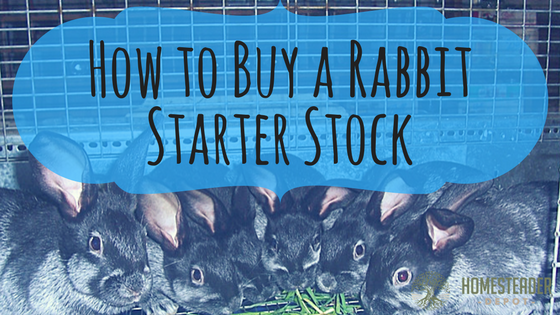
Rabbits are a great animal to raise on a homestead. They don’t take up much space, they breed very efficiently, are affordable to feed, and their meat is delicious.
Since one of the biggest appeals of raising rabbits is how quickly and easily they reproduce, you will need to get yourself set up with what’s called a starter stock. These will be the first rabbits you buy, that will go on to reproduce and build your herd.
Rabbit Breeders
To find your first rabbits, you’ll have to find someone who’s already selling them. A great place to look at first is a state fair. Even if you can’t find someone exhibiting at the fair, you might be able to ask around and get some leads. Additionally, there might be rabbitries in your area, or you can check your local newspaper for listings.
Another great place to find rabbit breeders would be your local feed store. They might have a bulletin where people would post rabbits for sale, or the employees might even know themselves of customers who breed and sell rabbits.
What Kind of Stock
As far as choosing which animals to buy, the most important thing is to buy healthy animals. There are a great many breeds of rabbits, both pure and mixed-breed too, but worry more about the health of the animals than the breed. If you are able to compare rabbitries, you will get a good sense of what a healthy animal looks like.
Be discerning and cautious; it’s not unlikely that a breeder might want to unload their inferior stock on someone else. Healthy rabbitries will be clean and well-tended, and healthy rabbits will be perky and happy, rather than lethargic and “droopy”. You can ask what the rabbits are being fed and their general care.
How Many Rabbits?
A great starting point with rabbits is to simply have a single rabbit as a pet, to get an idea for their care and needs, or a pregnant doe that you can start your herd with. One pregnant doe, once she has given birth, will provide you with plenty of progeny and meat within 6 months.
It is also common to start with two pregnant does and a mature buck, or one pregnant doe and one mature buck, plus a junior couple who can breed a little further down the road. These are very solid starting off points if you are serious about breeding rabbits.
Food
When you first introduce your rabbits to their new home, you’ll want to make sure they’re eating the same feed they had at their place of origin. Most animals simply adjust better to a new home if they have that familiarity.
Before taking rabbits home, see if you can buy some feed from the breeder in addition to the rabbits. You’ll want enough to get them adjusted and comfortable in their new homes. Once they start to settle in, you can gradually change them to the feed of your choice, if you’d like to feed them something else.
Transitioning to a different type of feed is easy; you simply start by giving them a small amount of the new feed mixed in with their old, familiar feed, and slowly adjust the proportions over time, until they are eating the new feed exclusively.
Quarantine
It’s always wise with any new animal you bring home to your homestead to quarantine them away from other animals for a few weeks. You wouldn’t want your new animals to get sick, or to bring a sickness to the animals you already have. Especially for animals raised in close proximity to others, like rabbits, this is very prudent. Odds are, no one will get sick, but it’s always better to be safe than sorry.
Breeds
Although it is pertinent to buy a healthy rabbit, it’s also good to be familiar with different rabbit breeds. You can do this by regularly attending county fairs, watching videos online, or checking out a book from your local library.
If you simply want to raise rabbits for pet, any breed will do. Go with whatever strikes your fancy.
To raise rabbits for meat, however, you’ll want to take a few factors into consideration. First of all, if you want to raise meat, do you want a breed that is normally sold commercially for meat, with a high amount of meat and a fast growth rate? Or perhaps something more unique, like a specialty breed?
Or perhaps you’d like to raise them for their pelts, in which case you’ll want to think about what color would be best, as well as the length of the fur. For example, Harlequin rabbits are calico patterned, while the chinchilla has a “ticked” fur. New Zealands, a very common breed, have more solid colors like white, red, or black. Angoras have long, fluffy hair, while the Rex breed has shorter, more velvet-like fur. There is a broad range of characteristics between these examples, as well.
Finally, consider size. There is everything from small, dwarf breeds, to giants.
Pedigree
Finally, consider the pedigree, if this is something that matters to you. There are 45 officially recognized rabbit breeds.
You by no means have to buy purebred, after all, health is the most important factor. It is common to find mixed breed stock, which will have the characteristics of one breed or another. Some of these rabbits might, in fact, be purebred, but without the proper paperwork they aren’t technically “pedigreed”.
If you’d like to raise purebred yourself, you need to understand the process it takes to get registered. This is done through the American Rabbit Breeders Association, and not only do you need to have the parents and grandparents of the rabbit you’d like to register, but the rabbit must be fully grown as well.
Raising rabbits is very rewarding and fun! If you start off right, you’re sure to be an expert breeder in no time.
If you enjoyed this, you might also like….
Long-Term Survival for Homesteaders…
Natural Healing Secrets You Need to Know…
Effective Primal Diet Hacks…





